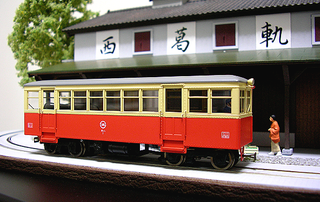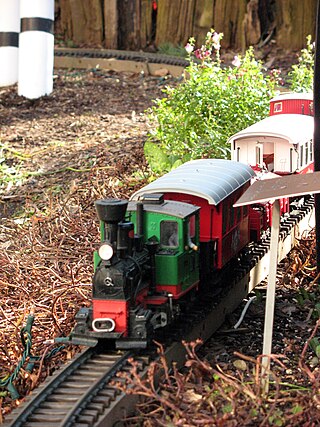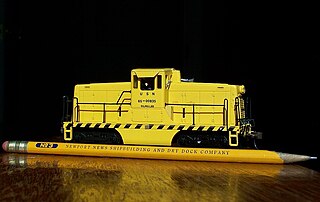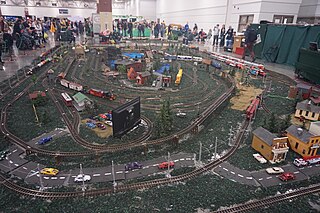
Railway modelling or model railroading is a hobby in which rail transport systems are modelled at a reduced scale.

LGB stands for Lehmann Gross Bahn - the "Lehmann Big Train" in German. Made by Ernst Paul Lehmann Patentwerk in Nuremberg, Germany, since 1968 and by Märklin since 2007, it is the most popular garden railway model in Europe, although there are also many models of U.S. and Canadian prototypes. LGB caused a revival of garden model railroading in the United States when it was introduced. LGB is sold in North America through Wm. K. Walthers, who took over from Ernst Paul Lehmann's subsidiary, LGB of America, when Märklin bought the LGB assets. Most of the European prototypes were manufactured in Germany, while much of the North American rolling stock was made in China. Production was later moved to Hungary.

O scale is a scale commonly used for toy trains and rail transport modelling. Introduced by German toy manufacturer Märklin around 1900, by the 1930s three-rail alternating current O gauge was the most common model railroad scale in the United States and remained so until the early 1960s. In Europe, its popularity declined before World War II due to the introduction of smaller scales.

HO or H0 is a rail transport modelling scale using a 1:87 scale. It is the most popular scale of model railway in the world. The rails are spaced 16.5 millimetres (0.650 in) apart for modelling 1,435 mm standard gauge tracks and trains in HO.

American Flyer is a brand of toy train and model railroad manufactured in the United States.

N scale is a popular model railway scale. Depending upon the manufacturer, the scale ranges from 1:148 to 1:160. Effectively the scale is 1:159, 9 mm to 1,435 mm, which is the width of standard gauge railway. However the scale may vary to simulate wide or narrow gauge rail. In all cases, the gauge is 9 mm or 0.354 in. The term N gauge refers to the track dimensions, but in the United Kingdom in particular British N gauge refers to a 1:148 scale with 1:160 track gauge modelling. The terms N scale and N gauge are often inaccurately used interchangeably, as scale is defined as ratio or proportion of the model, and gauge only as a distance between rails. The scale 1:148 defines the rail-to-rail gauge equal to 9 mm exactly, so when calculating the rail or track use 1:160 and for engines and car wheel base use 1:148.

TT scale is a model railroading scale at 1:120 scale with a Track gauge of 12 mm between the rails. It is placed between HO scale (1:87) and N scale (1:160). Its original purpose, as the name suggests, was to make a train set small enough to assemble and operate on a tabletop.

1 gauge, gauge 1 or gauge one is a model railway and toy train standard that was popular in the early 20th century, particularly with European manufacturers. Its track measures 1.75 in, making it larger than 0 gauge but slightly smaller than wide gauge, which came to be the dominant U.S. standard during the 1920s.
Z scale is one of the smallest commercially available model railway scales (1:220), with a track gauge of 6.5 mm / 0.256 in. Introduced by Märklin in 1972, Z scale trains operate on 0–10 volts DC and offer the same operating characteristics as all other two-rail, direct-current, analog model railways. Locomotives can be fitted with digital decoders for independent control. Model trains, track, structures, and human/animal figures are readily available in European, North American, and Japanese styles from a variety of manufacturers.

Hornby Hobbies Limited is a British-owned scale model manufacturing company which has been focused on model railways. Its roots date back to 1901 in Liverpool, when founder Frank Hornby received a patent for his Meccano construction toy. The first clockwork train was produced in 1920. In 1938, Hornby launched its first OO gauge train. In 1964, Hornby and Meccano were bought by their competitor, Tri-ang Railways, and sold when Tri-ang went into receivership. Hornby Railways became independent again in the 1980s, and became listed on the London Stock Exchange, but due to financial troubles reported in June 2017, became majority owned by British turnaround specialist Phoenix Asset Management.

Bachmann Industries is a Bermuda-registered, Chinese-owned company, globally headquartered in Hong Kong; specialising in model railroading.

Lionel Corporation was an American toy manufacturer and holding company of retailers that was founded in 1900 and operated for more than 120 years. It started as an electrical novelties company. Lionel specialized in various products throughout its existence. Toy trains and model railroads were its main claim to fame. Lionel trains have been produced since 1900, and their trains were admired by model railroaders around the world for the solidity of their construction and the authenticity of their detail. During its peak years in the 1950s, the company sold $25 million worth of trains per year.

Athearn is a United States manufacturer of model railroad equipment, produced and distributed by American hobby manufacturer Horizon Hobby, Inc. of Champaign, Illinois.

Life-Like was a manufacturer of model trains and accessories. In 1960, the company purchased the assets of the defunct Varney Scale Models and began manufacturing model trains and accessories under the name Life-Like in 1970. In 2005 the parent company, Lifoam Industries, LLC, chose to concentrate on their core products and sold their model railroad operations to hobby distributor Wm. K. Walthers. Today, the Life-Like trademark is used by Walthers for HO Scale Buildings.
Lima S.p.A. is an Italian brand and former manufacturing company of model railways. The company was headquartered in Vicenza for almost 50 years, from the early 1950s until the company ceased trading in 2004. Lima was a popular, affordable brand of 00 gauge and N gauge model railway material in the UK, more detailed H0 and N gauge models in France, Germany, Italy, Switzerland, and the United States as well as South Africa, Scandinavia and Australia. Lima also produced a small range of 0 gauge models. Lima partnered with various distributors and manufacturers, selling under brands such as A.H.M., Model Power, and Minitrain. Market pressures from superior Far Eastern produce in the mid-1990s led to Lima merging with Rivarossi, Arnold, and Jouef. Ultimately, these consolidations failed and operations ceased in 2004.

Atlas Model Railroad Company, Inc. makes scale models in N scale, HO scale, and O scale. The company is based in Hillside, New Jersey, United States. They produce a wide variety of locomotives, rolling stock, and vehicles. Atlas is well known for their flex track and codes 55, 80, 83 and 100 track. Atlas also produces a line of compatible structures and bridges.
Proto:87 is a model railroad special interest group founded in 1978, providing a finescale alternative to traditional HO gauge.
Mehano is a Slovenian toy company from Izola, founded in 1952 as Mehanotehnika. It produces a large range of both traditional and electronic toys, as well as model railroad equipment. The company has borne its current name of Mehano since 1990. Mehano applied to restructure in November 2008, following reported economic difficulties during the preceding ten years; production in Slovenia ended. In 2010, Mehano was relaunched with production in China and new branding.

On2 gauge is part of the hobby of rail transport modeling. The name is based on the common USA model railroad O scale of 1:48 and refers to the gauge between the rails and the fact that it is narrow gauge, thus 'On2'.

Trainfest is a model railroad show that takes place annually in the Milwaukee suburb West Allis, Wisconsin. According to the show’s organizers, it is “America’s largest operating model railroad show” and markets itself to both hobbyists and young families.
















